| |
In 1968, LTC John Byers (Col Ret) SCO of the 2/14 ACR
entertained the retired German General Hasso von Manteuffel at Daley
Barracks. Mantueffel presented a memorable briefing on the Battle of
the Bulge to the assembled officers. He was in a unique position to
speak on the battle having commanded the 5th Panzer Army during the
campaign and in retirement, had become an active speaker on the
subject in both Germany and the United States. In 1984, the officers
of the Blackhorse Regiment traveled through the major battlefields
of the Bulge to recall the last major German offensive in the West
during World War II and the heroic defense, then counter attack
mustered by the US Army.
We Sing of Others Glories Past
Ted Prescott
For several days in December 1984, the Regiment took
its officers for a terrain walk of the Battle of the Bulge
battlefield in Belgium. This was not an ordinary terrain walk by an
ordinary military school or unit, but a study of an extraordinary
battle staged and choreographed in typical Blackhorse fashion.
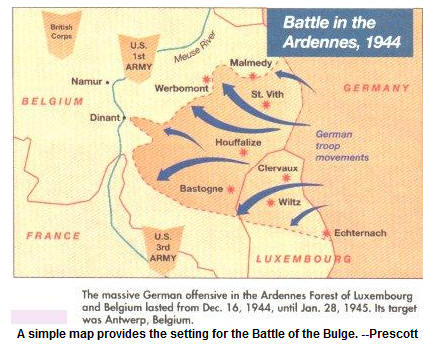
Prior to the start of the terrain walk, each squadron
was given an allotment of seats for the tour and volunteers were
solicited to conduct briefings at significant sites of the battle.
Once the officers were assembled, buses were boarded and the road
trip began. The first stop, though, was a military museum in
Muenster where every conceivable tank ever made was on display. It
was impressive, but only a hint of what waited ahead.
It's over twenty years since the event so my memory
is a bit clouded, but I think the first day in Belgium, the
regimental officers visited several locations where the Germans
broke through the American lines. The one thing that does stand out,
though, is that there was snow on the ground and it was bitterly
cold. I kept thinking of my feet in poorly insulated tanker boots;
none of this compared with what our soldiers went through during
that hard-fought battle we were studying. I kept my complaints to
myself.
As the officers got into the spirit of the event,
refrains of the World War II
began to filter through the buses. Popularized in a scene form the
Henry Fonda movie Battle of the Bulge, the song became an unofficial
road trip theme song as the Blackhorse armada of buses made its
rounds in Germany and Belgium. For the locals, used to seeing
American tourists in the former Bulge area, we must have presented
an odd site, young American officers in our camouflage BDUs, singing
songs that were absolutely "verboten" in modern German society.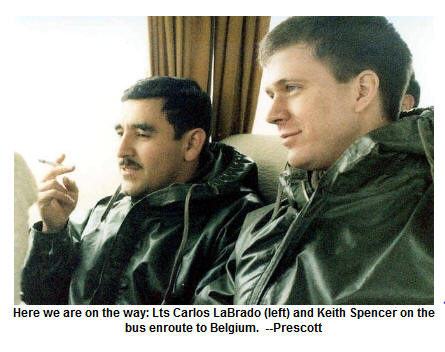
What made this trip standout was the Abrams
connection. LTC Jon Abrams was the commander of 1/11, and his
father, Creighton Abrams, spearheaded the 4th Armored division’s
thrust into Bastonge. Certainly a high point of the trip was the
briefing that took place at the spot where Abram’s tankers linked up
with the 101st Airborne. To our amazement, the regiment had brought
in Lt. Charles Boggess, who was the first tank commander to break
through the German lines and link up with the 101st.Airborne. Mr.
Boggess gave his account of the battle and the subsequent linkup
beside a bunker his tank had personally knocked out. The following
excerpt from John Toland’s book, The Battle of the Bulge,
essentially repeats what Charles Boggess told the regimental
officers that day:
Lieutenant Charles Boggess, a veteran at
thirty-three, was in the lead with his nine Cobra Kings, forty-ton
Shermans. Soon he was on the outskirts of Assenois. He called for
artillery support, then he gave the orders to attack. The nine tanks
headed straight for the town, all guns firing.
The story continues…
At 4:30 P.M. Boggess, followed by two other Cobra Kings was heading
for the woods north of Assenois. The barrel of his 75 was hot.
Gunner Dickerson had used it like a machine gun, throwing in
twenty-one rounds in the few minutes it had taken to blast through
the village.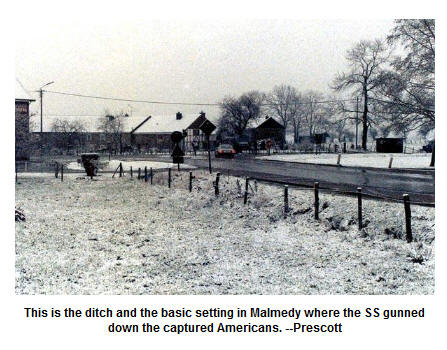
Boggess saw a concrete blockhouse painted green. He
ordered Dickerson to put three rounds into it. The concrete flew
apart A hundred yards farther Boggess saw colored parachutes draped
over the fields, in the trees. Then he saw foxholes ahead. But he
had no idea whether they were held by friends or foe. He stood up in
his turret and shouted, "Come here! This is the 4th Armored."
There was no answer. The tanker called again and
again. Several helmeted heads slowly, suspiciously rose. Then a
single figure came forward.
""I’m Lieutenant Webster of the 326th Engineers,
101st Airborne Division. Glad to see you." The paratrooper,
grinning broadly, extended a hand. Boggeess leaned down and shook
hands. The men of Bastonge were now in Patton’s Third army.
It was certainly an honor to have such a guest in our
midst.
The most sobering stop on the trip was the Malmedy Massacre site.
The ditch where many of the American bodies were found was still
beside the road, as well as the wood line on the other side of the
field where a few GIs fled once the firing started. Even a new café
had been built to replace the one burned by the SS troops as they
flushed out the Americans that had escaped once the executions
started. Their escape from death, though, was only temporary. The
prisoners were shot as they fled the burning building. Though the
crossroads near Malmedy was the only spot we stopped at to reflect
on the war crimes committed during the battle, the buses passed
several other spots where the advancing Germans murdered American
POWs and Belgium citizens.
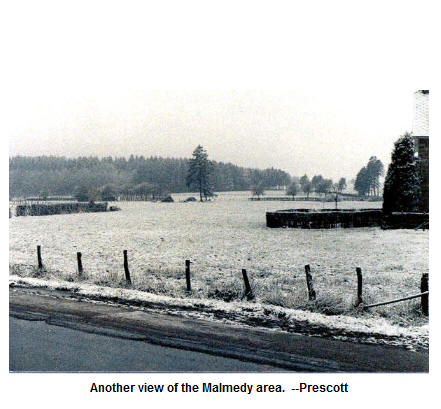
From Malmedy, the tour stopped for other
presentations, and it was capped off at one briefing location when a
reconditioned M-4 Sherman lumbered down a snowy road toward the
regimental officers. Had there been any German veterans of the
battle among the group they would have instinctively ran for the
woods! An awesome sight that hadn’t been witnessed in those cold,
silent woods since 1944. And without saying, done in typical
Blackhorse fashion.
Sometime during the tour there was a dinner with all
the officers and bus drivers, and as the beer flowed verses of the
Panzer Lied rang out once more. From what I recall, it was a rowdy
affair, as the officers climbed on the bus the next morning there
were blood-shot eyes and an uncharacteristic silence causing one of
the German bus drivers to remark, "well they aren’t singing now."
The Rest of the Story
We are always looking for hidden links and odd twists
to stories related to the US cavalry, Daley Barracks and Manteuffel
Kaserne. It’s our version of the , “ Six Degrees of Separation “
game. The Bulge was a massive battle, hundreds of thousands of
soldiers participated in the fight. There is a lengthy but worth
while
Internet history of the battle here. Kicking the topic around, we came upon three interesting sidelights
to the story that tie it to the theme of the American experience at
Daley Barracks. Hasso von Manteuffel and the briefers on the
Blackhorse trip to Belgium may have missed these highlights.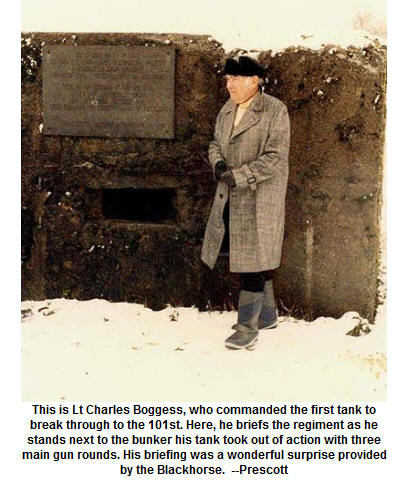
Malmedy Massacre Link
There is a very tenuous link between Daley
Barracks and the Malmedy Massacre. In Hidden Story The Army
Air Force and Manteuffel Kaserne, Bill McCaskill recalled driving
over to Nuremberg with Colonel Dorr to watch the War Crimes Trials.
We take Bill at his word, but Nuremberg was “ a tough ticket to get
“, the defendants were the most senior Nazi politicians, bureaucrats
and generals. It was much easier to watch the proceedings of
the “ second level “ war crime trials that were held on the grounds
of the Dachau concentration camp near Munich.
The most famous trail at this location
was the prosecution of the SS soldiers implicated in the massacre of
captured US troops during the bulge. The photograph of the
bodies of the American soldiers taken during the recovery and crime
scene investigation is one of the most reproduced WW II images
related to the American military. There are two links of note:
There is a lengthy but very well written
and illustrated investigation into the criminal proceedings brought
against the SS men tried at Dachau for the massacre. In light of
everything you think you know about the trail, the shooting of
prisoners and the US Army,
you will be very surprised by the
article.
The 2 Panzer Link
The 2nd Panzer Division participated in
the Wacht am Rhine offensive in Belgium in December, 1944, although
it was not a part of Manteuffel’s 5th Army. Rather, it was a
part of the LVIII Panzerkorps, subordinate to the 7th Army.
The unit had been badly depleted in previous weeks of fighting but,
about a month prior to the offensive, had been partially
reconstituted. The 2nd Kradschutzen Battalion that had been
stationed in Bad Kissingen a few years before, had long since been
merged with the Division’s reconnaissance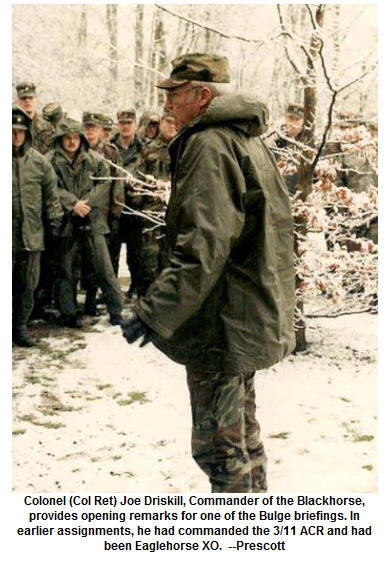 battalion.
Considering the long years of fighting, personnel replacement pool
centered in Austria and numerous re - builds, if there were any
troops who recalled Bad Kissingen as a duty station, it would have
been purely coincidental. The Division does hold a place of
significance in the annals of the battle. The 2nd Panzer,
commanded by Major General Meinrad von Lauchert, one of the rising
young stars of the Wehrmacht, was operating at well under 60%
strength, yet it achieved the deepest penetration by any German unit
of US lines during the Battle of the Bulge. Once the offensive
was spent, Lauchert brilliantly maneuvered his forces through a
series of delays and hasty defensive positions to withdraw in good
order and regain contact with the retreating German Corps. battalion.
Considering the long years of fighting, personnel replacement pool
centered in Austria and numerous re - builds, if there were any
troops who recalled Bad Kissingen as a duty station, it would have
been purely coincidental. The Division does hold a place of
significance in the annals of the battle. The 2nd Panzer,
commanded by Major General Meinrad von Lauchert, one of the rising
young stars of the Wehrmacht, was operating at well under 60%
strength, yet it achieved the deepest penetration by any German unit
of US lines during the Battle of the Bulge. Once the offensive
was spent, Lauchert brilliantly maneuvered his forces through a
series of delays and hasty defensive positions to withdraw in good
order and regain contact with the retreating German Corps.
The 14th Cavalry Link
Vehicles of the 14th Cavalry Group, the antecedent unit of the 14th
Constabulary Regiment of the immediate post war period in Germany
and in turn, in the direct lineage of the 14th Armored Cavalry
Regiment of the Cold War appear in one of the most famous
photographic sequences of the Battle of the Bulge. It was just an
accident of fate, but here is the story.
Not Our Best Day but a Memorable Week
- Quoted sections from the 14th ACR Regimental History 1952
The history, traditions and lineage of the 14th Cavalry recall that
the unit was initially inactivated in 1942 and the reactivated as
the 14th Armored Regiment of the 9th Armored Division. However, in
the interests of tradition,
“In 1943, in order to perpetuate the traditions, history and battle
honors of the 14th Cavalry Regiment, the regiment was consolidated
with the Headquarters and Headquarters Troop, 14th Cavalry Group,
and the Coat - of Arms of the 14th Regiment was transferred to the
HQ and HQ Troop, 14th Cavalry Group. “
As the Army began offensive operations in Africa, Italy and finally,
after the Normandy invasion, in France, Cavalry Groups and their
subordinate reconnaissance battalions - squadrons were attached and
cross attached to US divisions - corps as deemed necessary by senior
commanders. It was not uncommon to find a Group HQ with all
subordinate units detached to other units. When the attachment
ended, they returned to Group control either for operations at the
front or rest and refitting in rear areas.
During the winter of 1944, the 14th Cavalry Group consisted of the
18th Squadron, detached and attached to the 2nd Infantry division,
and the 32nd Squadron, detached and attached to the 83 Infantry
Division. In December, the 18th was “ chopped “ to the 106th
Infantry Division still in sector. The tasks for these squadrons
were the traditional cavalry missions of screening to the front and
reconnaissance in what had become a dark, cold and deep winter halt
in the war.
On 12 December, the 32nd Squadron was returned to Group control and
passed lines to the rear for refitting. The 18th Squadron also
retuned to Group control but continued its screening mission in the
Ardennes region of Belgium. The snow fell and the temperatures
dropped.
“At 0630 on 16 December 1944, Von Rundstedt launched the final
German bid for victory - the now famous ‘ Ardennes Offensive ‘ or
better known as the ’Battle of the Bulge ‘. After a terrific
artillery and rocket barrage designed to destroy communications and
disrupt our organization, the German attack was launched. The full
weight of this drive was felt early that morning when more that half
of the 18th Cavalry Squadron became surrounded, and were captured or
killed by 10 00 hrs.”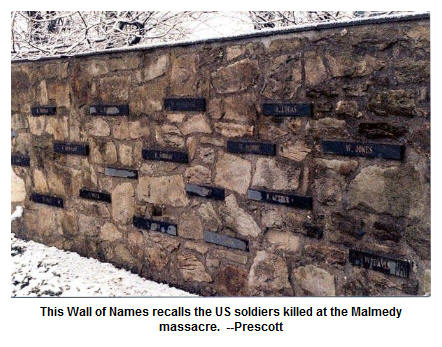
The day continued as Group desperately tried to re gain control and
organize a defense. The remained of the 18th Squadron fell back,
under almost constant pressure from the German 18th Volksgrenadier
Division. Each road crossing, farm hamlet and small hill was
contested, some changed hands two or three times that day.
On the 18th of December, Group and what remained of the 18th
Squadron had consolidated in the town of Vielsam, Belgium and were
attached to the US 7th Armored Division and, designated as the 14th
Squadron, ordered back into the fight. The entire area was bearing
the full brunt of the German offensive. American forces held on to
towns and hill top defensive positions while the lead German
divisions by passed the area and follow on units pressed the attack
on the US “ goose eggs “. On 23 December, the encircled US Forces
broke out to the West to reestablish contact with the deeply dented
US lines. The 14th Squadron was in the lead of the initial attack.
“The composite 14th Squadron held the crust on the southern part of
the perimeter while all friendly troops withdrew and then when they
became cut off by the fast moving German Panzer columns, destroyed
their vehicles and infiltrated out on foot through the 82nd Airborne
Division dug in along the Salm River.”
The Power of Photographs
From the first days of combat in Poland, the German Ministry of
Propaganda “ embedded “ reporters and both still and motion picture
photographers into front line units. These men were professionals
at their trade, one need look no further than the History Channel to
see their work, 95% of the German military - in - action films were
shot by these men. After the war, the vast photo files fell into the
hands of the Allies.
Both the stills and the motion pictures certainly convey the feeling
of the battle, interestingly, many of the more dramatic scenes were
more or less “ staged “. To get the “ shot “ is one thing, to get
shot is quite another. One of the most dramatic scenes from the
German side of the Battle of the Bulge, caught in both motion
pictures and stills, and watch any documentary on the battle and it
will be part of the footage, shows a group of combat weary SS men in
full combat gear, moving through and picking over, a shot up
American convoy in the deep snow. The vehicles still smolder, the
soldiers light up cigarettes and press the battle forward.
It took a while for the post war photo historians to pull the story
together, based on the German war reporter’s notes, the SS unit
caught on film and a study of the ebb and flow of the battle. The
American vehicles seen in the photos are elements of the 14th
Cavalry Squadron, probably on 17 or 18 December, when one of the
recon companies was caught on a road and over run. The battle had
been over for several hours and the SS unit seen on film was
actually a follow on force. The German film crew took advantage of
the situation, “ Achtung!! Lights … Kamera … now look like you are
in action!“.
| |
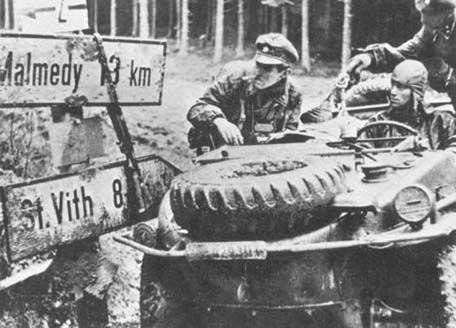
At left, LTC Joachim Peiper, with his VW Schwimwagen, in command of
a SS Battle Group Peiper. A German war reporter stages the photo as
Peiper turns toward Malmedy and the eventual site of the massacre.
|
|
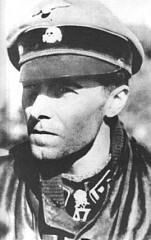
Another view of Peiper, he had movie star good - looks, was a proven
combat leader and bore the responsibility for the crimes his unit
committed. |
|
| |
|
|
|
|
| |
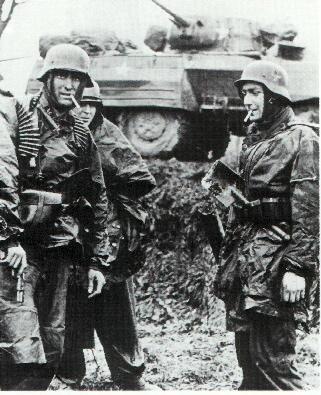 |
|
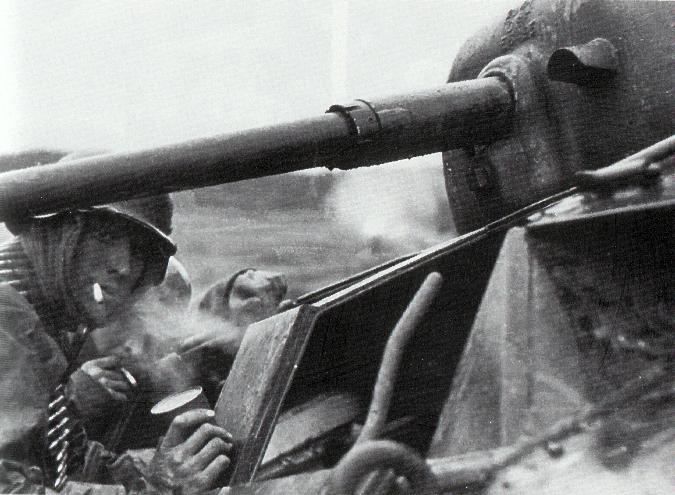 |
|
| |

These photos are the still images shots of a German war reporter as
an SS unit passes by a destroyed company of the 14th Cavalry
Squadron. The movie footage of this same event is often seen on TV.
|
|
|
|